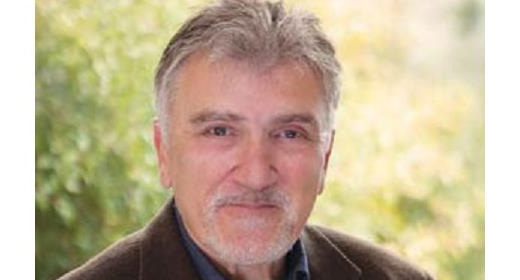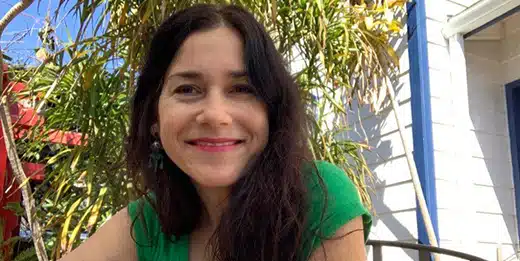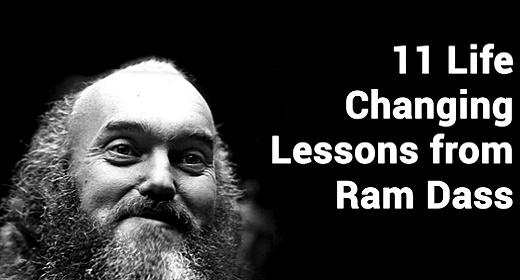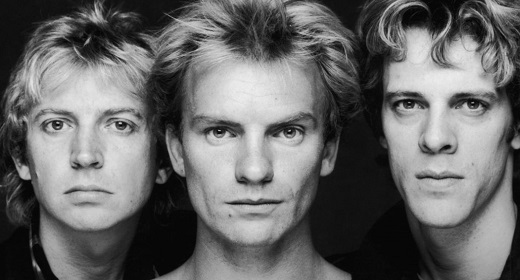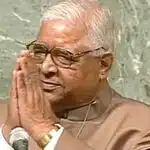Megan Larson: Yeah, it’s really just that access of breath in moments of activation. Certainly, there’s so many wonderful techniques, but in terms of the play and the play process with the children, it’s more just modeling the breath and then also utilizing the body. It’s like rubbing the legs or butterfly kisses, as I like to call them, like… as a way to soothing.
DONNA: You would invite the anxious child… you work with children, to use touch, and what does that do…?
MEGAN: It’s basically that soothing component of helping the nervous system to be able to regulate. When we say “regulate,” it’s not making calm, it’s about being in the intensity. In the play process, it’s organic, and as the therapist, you’re just modeling that. You’re not even suggesting it really. It’s really incredible because children learn through observation. We were talking earlier about these templates that we gather from different people in our life, like our parents or teachers or to see how they work through things, so it’s more just that modeling in the moment. If there’s anxiety in the room or agitation, it’s just a connecting back, just a modeling and then a naming.
DONNA: You mentioned play and I was reading about play therapy, but I must confess, I don’t know much about it in terms of its clinical application. Can you share that with us?
MEGAN: Sure. The model that I’m trained in, which is Synergetic Play Therapy… it’s really based on the child… sets the therapist or the toys or the games or whatever it is that they use… to share what it feels like to be them. Then through the projective process, feelings are named, and modulation or regulation rather, is modeled. It’s very organic and that’s why I love it because I did a lot of training as an undergrad and it was always very theoretical and analytical. Although there’s wisdom in some of those techniques, of course, for me, I just felt like I couldn’t be me.
I felt like it was so hard to just like show up because I was trying to always orchestrate things. What I love about this model is the child guides the process. How they relate to things gives us then information about their inner worlds. How did they speak to the toys or how did they speak to me or their body language? It’s all information about how they are connecting with themselves.
DONNA: Oh, that’s interesting. They would use the doll as a stand-in, in order to share with you what happened or tell their story about what they’re feeling. They might say, “Mary, my doll, is feeling sad today,” or make it about Mary to make it less uncomfortable for themselves. Something like that?
MEGAN: Sometimes yes, sometimes. Or how they’re even relating and treating that baby doll. Is that baby doll being nurtured and held, or is that baby doll being thrown across the room? Because we can get a lot of information from that.
DONNA: Yeah.
MEGAN: Right? Like if that baby doll’s getting thrown across the room or not taken care of as the observer. Oh, that’s hard to watch.
DONNA: Yeah.
MEGAN: Right? That’s giving us some information about how that child is seeing themselves. Because when we’re in the right relationship with the self, of course, there’s going to be nurturing and care and empathy and compassion. Yeah, take care of it.
DONNA: Is this what you referred to as the projective process?
MEGAN: Right. We set others up to feel what it feels like to be us. Yeah, we set each other up to feel what it feels like to be us, and I guess in the simplest terms, I always think about this as, when I’m connecting with somebody, how it feels to be in a relationship with them, it’s like the words they’re using, how they’re relating. When people are having a really hard time, and sometimes you can feel it, it feels like there’s a rigidity or a closing down. It’s information to them. Yeah, to know what’s maybe taking place in terms of their connection with themselves.
DONNA: I want to go back to this idea of the stigma when it comes to the domain of mental psychological challenges. It seems like the last 20 years were becoming… or at least, as an educator, although I teach at a higher level, there’s still more… it seems like there’s more occurrence of ADHD, and the autism spectrum. This language is becoming more mainstream, even in movies, we hear about it more often. In my day, when I was going to school, nobody had ADHD or any of these things. Is it that we’re becoming more willing to talk about it, or is there more actual occurrence of it? Is it more widespread than it used to be?
MEGAN: It’s a really good question. I don’t know. I actually don’t know the answer. What I do know is I’m really intrigued by Gabor Maté research.
DONNA: Oh, yeah.
MEGAN: Very much so. Some of the theories he has around ADHD. The other thought that I have is attention or Nature Deficit Disorder. I think that’s a real thing that’s happening for children. It’s basically, there’s a lot of research around how
children’s time outdoors has been completely cut in half, if not more so, recess is getting shortened. Just their time to just be kids and be outside and connecting with the natural world has really over time, just as a society, we’ve gotten really far away from… their communities where they uphold those values and are able to do that. But I think that’s a huge piece. I think nature is such a healer.
DONNA: Yes.
MEGAN: In terms of helping kids really be present with themselves. I think I went a little off topic, but it was making me think…
DONNA: No, maybe there, it is more widespread because of this shift away from nature.
MEGAN: Yes.
DONNA: Yeah, I would agree with that wholeheartedly. It seems reasonable. I was reading an article about Finland… that they are one of the communities that prioritize play in the outdoors, rather than the classroom canon, so to speak.
MEGAN: Yes.
DONNA: They’ve come in on the happiest country list, besides Bhutan… I think this is their second run. There seems to be a correlation, so I would agree with you wholeheartedly.
MEGAN: Totally. I think getting kids in nature is such an important thing and even if it’s just five minutes a day, just like sitting on the ground, looking up at the clouds, but to help…. Yeah, to help have them be able to connect back, I think, is so important. I think it’s a huge piece of just what we’re seeing in terms of mental health in general. I think the pressure that kids have on them around success and excelling in terms of academics… it’s really, I would say pretty unrealistic.
DONNA: Yeah.
MEGAN: I think it can create challenges too in how a child sees themselves. Because if I am being evaluated on how I perform, then it’s going to be really hard for me to feel like I’m okay as I am when I don’t perform the way that I’m supposed to, or what is being asked of me. I think that another piece of my work is to help, help to expand more conversation around children’s intrinsic qualities and support the parents, things that aren’t dependent on performance. Like kindness, sense of humor, art, being creative, but having it be more opportunity for there to be, yeah, more space around the definitions of how one sees oneself.
DONNA: Yeah. That academic emphasis on academic performance would seem to only increase anxiety.
MEGAN: Yeah. Definitely.
DONNA: You talk about part of the reframing process, circulating around more compassion, less judgment, which I love. How do we do that individually, when you work with individual families, but also collectively?
MEGAN: Yeah. I think it starts with the individual. I think each one of us holds that power or that, yeah, to influence and to have it ripple out into the collective. But in my work with people, it’s really to be able to hold the different parts of oneself that may have gotten fragmented due to trauma or really challenging experiences where we couldn’t integrate, and to be able to look at it from a lens of compassion. It’s almost like going back and holding one in that love and that understanding of the experience or whatever didn’t get integrated due to various causes and conditions.
DONNA: Yeah.
MEGAN: I’ve been really blessed, you were mentioning how I’ve studied with some of the Tibetan teachers and some of those trainings have been instrumental in my life as a way to work with challenges, even simple meta practice. May I be well, may I be happy, may I be peaceful, has been really a foundation for…
DONNA: I love that.
MEGAN: Yeah.
DONNA: Can you share more about that? I just love that so much about your experience in learning about these Tibetan techniques and then how you apply it in your work. I’d love to hear more about that.
MEGAN: Yeah, completely. Again, it goes back to that normalization of feelings. I’m thinking even embarrassment is a big one with teenagers because that’s something that I think all of us do, being embarrassed, it’s awkward and it can be a hard moment. I always referenced this funny… It’s funny now, but it wasn’t funny at the time when I was a new therapist, and I just opened my practice, and I had this beautiful office and I was so excited to see people.
One of the first encounters that I had with a client… I got up to get out of my chair and I actually fell, like I literally propelled forward and fell on my face. It was this moment of just sheer embarrassment. “Oh wow, Megan, you just fell.” But those practices were game changers for me because it was a way… it’s like, “Yes, I fell and everyone falls.” Do you know what I mean? Just to also hold at that moment… it felt like it was the end of the world. But then to come back to compassion.
DONNA: Yeah.
MEGAN: Just like, “Okay, we have embarrassing moments in life and it’s okay.” It doesn’t define who you are.
May I be happy, may I be well, may I be peaceful, as a way to just ground and center back.
DONNA: The compassion applies to ourselves too.
MEGAN: Oh, totally.
DONNA: Let’s make sure… I want to have it right because it’s so simple and so beautiful. May I be happy, may I be well, may I be peaceful? Is that it?
MEGAN: I love that one. Yep.
DONNA: It’s so simple and it’s like a little prayer, almost.
MEGAN: Completely. Then the Four Immeasurable’s, which is a little bit more like the formal Buddhist training. Could be, May I or May you have happiness, and the cause of happiness. May you be free from suffering and the cause of suffering. May you abide in equanimity, free from attachment and hatred and what’s the last one? May you never be separate from joy that knows no sorrow.
DONNA: That’s beautiful.
MEGAN: Which I love.
DONNA: You teach this to children who are going through any kind of challenge, I suppose… it’s not specific to any one thing… to phobias or anxiety? I suppose it’s just multipurpose?
MEGAN: Multipurpose completely. Sometimes its application might look a little bit different. It might be that modeling back to self and naming that was really hard for me. I’m going to take a deep breath and remind myself that I’m okay, even though I just totally got that wrong. It might look a little different based on just where the client’s at and how they’re presenting.
DONNA: Yeah.
MEGAN: But certainly, with some of the teenagers and the young adults and adults that I work with, it’s very much a huge piece of the work.
DONNA: That’s beautiful. Do you also use mindfulness techniques?
MEGAN: Yes.
DONNA: Well, it’s funny that this is a word that has become a buzzword, I’d say the last couple of decades. But I think that it’s been so misconstrued and misunderstood from your understanding, what exactly is it and how do you apply it?
MEGAN: When I think of
mindfulness, I guess this probably goes back to some of my Buddhist training, but I always come into the word
awareness, just like awareness to be able to witness, and from that place, becoming more present. One technique that I use a lot with people in my work is
orientation. In this simplest way, it’s having them tune into where they are, how they’re feeling, what’s arising, both internally and then what they’re visually seeing, as a way to help ground and come into the present moment.
This is especially important with trauma, when we’re working with trauma too, to help ground and help orient, so simply to just ask what are you seeing or how are you feeling or what’s coming up for you? I noticed that you just got up and moved your leg. I’m wondering how your leg was feeling, right? To just bring more to the present moment and to expand that self-awareness piece.
DONNA: I remember once I was in a
Zen meditation circle and someone asked in a funny way, but he was quite serious, “What’s the big whoop about
now? What if now just sucks? What is the big whoop about now?
MEGAN: Well, I think the big whoop about now is that we’re not lost in our stories about the future, or we’re not ruminating in experiences of the past. It helps so much, I think in terms of just when we’re able to access that, it’s like this amazing gift because then we’re not lost in the mental chatter and if we are, even if those thoughts arise, which of course are going to arise, we’re able to come back. It’s just that attuning back when we go on in the past or when we go flying into the future.
DONNA: Yeah.
MEGAN: Come back to… and what about right now? I think it’s so healing for me. It’s been a huge piece of my healing journey and just what’s been so…
DONNA: Would you share that? What has grounded your own journey and what brought you to these eastern teachings and was that a part of your journey?
MEGAN: Totally. I often reflect on my work with children and how I started to do this work. I think it was out of my own childhood. As a child, I had medical trauma and later in my youth a lot of substance abuse issues, so I found meditation.
DONNA: You personally?
MEGAN: Yes, me personally.
DONNA: Oh.
MEGAN: Me, personally. I’m so grateful for those experiences because I feel like it’s helped me to understand and have a level of compassion for what people go through.
DONNA: Absolutely.
MEGAN: I feel like, without that, I don’t think I’d be doing this work.
DONNA: Yeah.
MEGAN: I’d probably be doing something else.
DONNA: Absolutely.
MEGAN: I feel like it was foundational for me. But as a child, and even as a younger youth, I struggled a lot with that. Then part of my healing… I did a program and then I got out of the program, and I realized I wanted to be a therapist. I got to learn a lot about myself and along the way I found yoga and meditation, which totally changed my life in profound ways. I think from that, it just became very clear that I wanted to share what I had found to be helpful, with others.
Read and Watch Part 3 Here: Awaken Interviews Megan Larson Pt 3 -This Human Realm, Is The Saha Loca and It’s For the Courageous Ones
Read and Watch Part 1 Here: Awaken Interviews Megan Larson Pt 1 – Leading Through the Heart Instead of Through the Intellect

